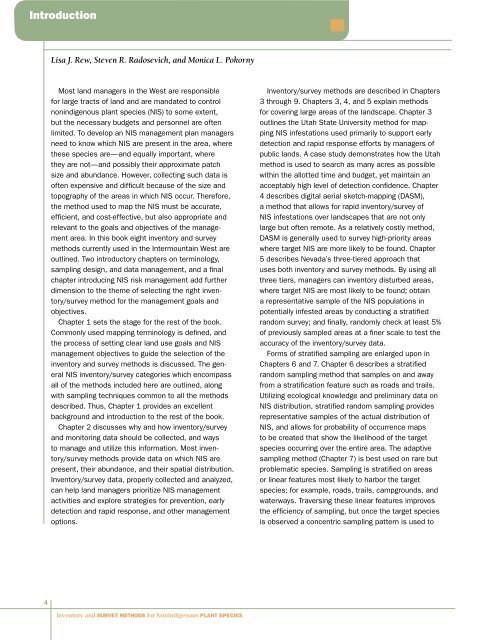Inventory and Survey Methods for Nonindigenous Plant Species (PDF)
Inventory and Survey Methods for Nonindigenous Plant Species (PDF)
Inventory and Survey Methods for Nonindigenous Plant Species (PDF)
- No tags were found...
You also want an ePaper? Increase the reach of your titles
YUMPU automatically turns print PDFs into web optimized ePapers that Google loves.
IntroductionLisa J. Rew, Steven R. Radosevich, <strong>and</strong> Monica L. PokornyMost l<strong>and</strong> managers in the West are responsible<strong>for</strong> large tracts of l<strong>and</strong> <strong>and</strong> are m<strong>and</strong>ated to controlnonindigenous plant species (NIS) to some extent,but the necessary budgets <strong>and</strong> personnel are oftenlimited. To develop an NIS management plan managersneed to know which NIS are present in the area, wherethese species are—<strong>and</strong> equally important, wherethey are not—<strong>and</strong> possibly their approximate patchsize <strong>and</strong> abundance. However, collecting such data isoften expensive <strong>and</strong> difficult because of the size <strong>and</strong>topography of the areas in which NIS occur. There<strong>for</strong>e,the method used to map the NIS must be accurate,efficient, <strong>and</strong> cost-effective, but also appropriate <strong>and</strong>relevant to the goals <strong>and</strong> objectives of the managementarea. In this book eight inventory <strong>and</strong> surveymethods currently used in the Intermountain West areoutlined. Two introductory chapters on terminology,sampling design, <strong>and</strong> data management, <strong>and</strong> a finalchapter introducing NIS risk management add furtherdimension to the theme of selecting the right inventory/surveymethod <strong>for</strong> the management goals <strong>and</strong>objectives.Chapter 1 sets the stage <strong>for</strong> the rest of the book.Commonly used mapping terminology is defined, <strong>and</strong>the process of setting clear l<strong>and</strong> use goals <strong>and</strong> NISmanagement objectives to guide the selection of theinventory <strong>and</strong> survey methods is discussed. The generalNIS inventory/survey categories which encompassall of the methods included here are outlined, alongwith sampling techniques common to all the methodsdescribed. Thus, Chapter 1 provides an excellentbackground <strong>and</strong> introduction to the rest of the book.Chapter 2 discusses why <strong>and</strong> how inventory/survey<strong>and</strong> monitoring data should be collected, <strong>and</strong> waysto manage <strong>and</strong> utilize this in<strong>for</strong>mation. Most inventory/surveymethods provide data on which NIS arepresent, their abundance, <strong>and</strong> their spatial distribution.<strong>Inventory</strong>/survey data, properly collected <strong>and</strong> analyzed,can help l<strong>and</strong> managers prioritize NIS managementactivities <strong>and</strong> explore strategies <strong>for</strong> prevention, earlydetection <strong>and</strong> rapid response, <strong>and</strong> other managementoptions.<strong>Inventory</strong>/survey methods are described in Chapters3 through 9. Chapters 3, 4, <strong>and</strong> 5 explain methods<strong>for</strong> covering large areas of the l<strong>and</strong>scape. Chapter 3outlines the Utah State University method <strong>for</strong> mappingNIS infestations used primarily to support earlydetection <strong>and</strong> rapid response ef<strong>for</strong>ts by managers ofpublic l<strong>and</strong>s. A case study demonstrates how the Utahmethod is used to search as many acres as possiblewithin the allotted time <strong>and</strong> budget, yet maintain anacceptably high level of detection confidence. Chapter4 describes digital aerial sketch-mapping (DASM),a method that allows <strong>for</strong> rapid inventory/survey ofNIS infestations over l<strong>and</strong>scapes that are not onlylarge but often remote. As a relatively costly method,DASM is generally used to survey high-priority areaswhere target NIS are more likely to be found. Chapter5 describes Nevada’s three-tiered approach thatuses both inventory <strong>and</strong> survey methods. By using allthree tiers, managers can inventory disturbed areas,where target NIS are most likely to be found; obtaina representative sample of the NIS populations inpotentially infested areas by conducting a stratifiedr<strong>and</strong>om survey; <strong>and</strong> finally, r<strong>and</strong>omly check at least 5%of previously sampled areas at a finer scale to test theaccuracy of the inventory/survey data.Forms of stratified sampling are enlarged upon inChapters 6 <strong>and</strong> 7. Chapter 6 describes a stratifiedr<strong>and</strong>om sampling method that samples on <strong>and</strong> awayfrom a stratification feature such as roads <strong>and</strong> trails.Utilizing ecological knowledge <strong>and</strong> preliminary data onNIS distribution, stratified r<strong>and</strong>om sampling providesrepresentative samples of the actual distribution ofNIS, <strong>and</strong> allows <strong>for</strong> probability of occurrence mapsto be created that show the likelihood of the targetspecies occurring over the entire area. The adaptivesampling method (Chapter 7) is best used on rare butproblematic species. Sampling is stratified on areasor linear features most likely to harbor the targetspecies; <strong>for</strong> example, roads, trails, campgrounds, <strong>and</strong>waterways. Traversing these linear features improvesthe efficiency of sampling, but once the target speciesis observed a concentric sampling pattern is used to<strong>Inventory</strong> <strong>and</strong> <strong>Survey</strong> <strong>Methods</strong> <strong>for</strong> <strong>Nonindigenous</strong> <strong>Plant</strong> <strong>Species</strong>
















